Feeding Exotic Birds: What’s Safe and What’s Not
Proper nutrition is crucial for the health and longevity of pet birds, with different species requiring specific dietary considerations to thrive in captivity. Many bird owners are unaware that their parrot’s diet plays a significant role in determining its overall health. Contrary to popular belief, most parrots should not be fed seed mixes, as they…
Proper nutrition is crucial for the health and longevity of pet birds, with different species requiring specific dietary considerations to thrive in captivity.
Many bird owners are unaware that their parrot’s diet plays a significant role in determining its overall health. Contrary to popular belief, most parrots should not be fed seed mixes, as they lack essential nutrients.
A well-balanced diet for parrots should include a combination of high-quality pellets and fresh foods. Understanding what foods are toxic to birds is crucial for preventing potentially fatal health issues.
Key Takeaways
- A well-balanced diet is crucial for the health and longevity of pet birds.
- Different bird species have specific dietary needs.
- High-quality pellets and fresh foods are essential for a parrot’s diet.
- Seed mixes are not suitable for larger parrot species.
- Understanding toxic foods is vital for preventing health issues.
Understanding the Nutritional Needs of Exotic Birds
Understanding the nutritional needs of exotic birds is crucial for their health and well-being in captivity. Exotic birds, such as parrots, have specific dietary requirements that are shaped by their natural habitats and behaviors.
Natural Diet vs. Captive Diet
In the wild, birds have evolved specific dietary adaptations based on their native habitats. For instance, different species consume varying proportions of seeds, fruits, nuts, insects, and vegetation. However, captive environments cannot perfectly replicate these wild feeding patterns, necessitating carefully formulated diets that meet all nutritional requirements while accounting for reduced activity levels.
| Dietary Component | Wild Birds | Captive Birds |
|---|---|---|
| Fruits and Nuts | Varied, less sugar, more fiber | Formulated to meet nutritional needs |
| Seeds and Vegetation | Depends on species and habitat | Carefully selected for balanced nutrition |
| Insects and Proteins | Important for some species | Supplements used to ensure adequate protein |
Metabolism and Energy Requirements
Metabolism varies significantly between bird species. Smaller birds like budgies have faster metabolisms requiring more frequent feeding, while larger parrots may have different energy requirements. 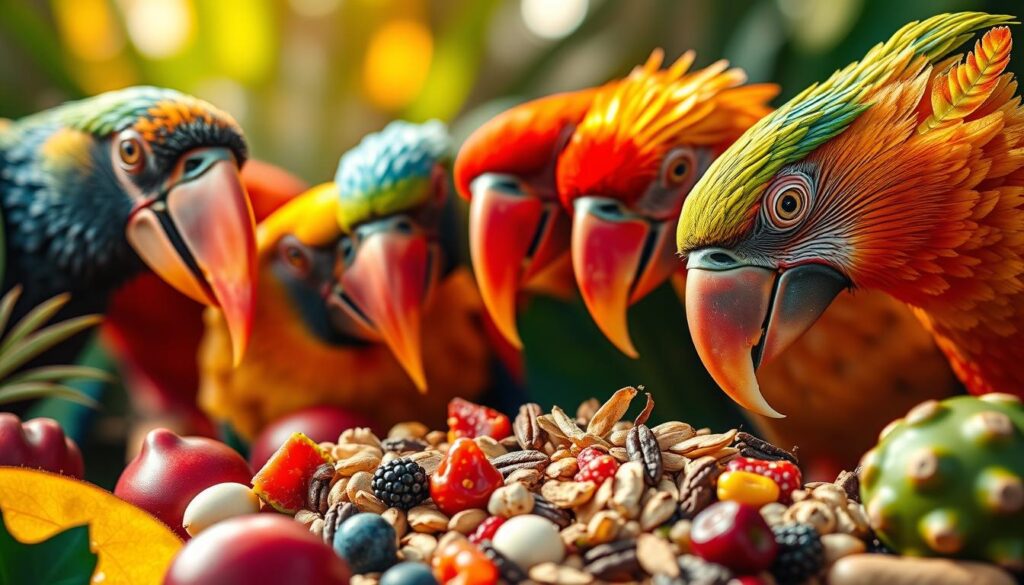
By recognizing the unique nutritional needs and metabolic rates of different bird species, owners can create more effective and healthy diets for their exotic birds.
The Ideal Diet Composition for Pet Birds
Understanding the ideal diet composition is vital for ensuring your exotic bird lives a long and healthy life. A balanced diet is crucial for maintaining the overall health and well-being of your pet.
Pellets: The Foundation of a Healthy Diet
Pellets should make up 50-70% of your parrot’s diet, as recommended by board-certified avian veterinarians. The best pellets are those that are free from additives like sugar or dyes, which can have long-term negative effects on your bird’s health. Recommended pellet brands include Lafeber, Harrison’s, and Roudybush.
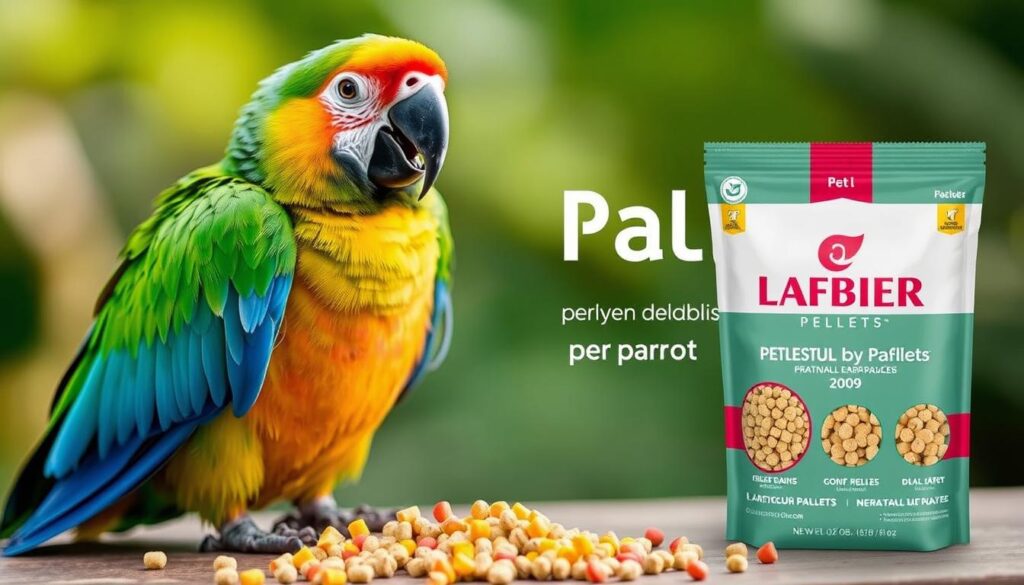
Fresh Foods: Essential Supplements
Fresh foods should comprise 30-50% of your bird’s diet, including a variety of vegetables, limited fruits, and appropriate grains. These foods provide essential vitamins, minerals, and phytonutrients not found in processed foods.
Treats and Occasional Foods
Treats should be limited to no more than 10% of the overall diet, focusing on nutrient-dense options rather than empty calories or potentially harmful human foods. It’s essential to choose treats wisely to maintain your bird’s health.
A well-balanced diet is key to ensuring your exotic bird remains healthy and happy. By combining high-quality pellets with fresh foods and limited treats, you can provide your pet with the nutrients it needs to thrive.
Safe and Healthy Foods for Exotic Birds
A well-rounded diet is essential for maintaining the health and happiness of exotic birds. The remaining 30-50% of a parrot’s diet should be composed of fresh foods, including raw or steamed vegetables, cooked whole grains, and limited amounts of raw fruit.
Vegetables Your Bird Will Love
Dark leafy greens like kale, spinach, and collard greens provide essential vitamin A and calcium, making them excellent staples in any bird’s diet. Colorful vegetables including bell peppers, carrots, sweet potatoes, and broccoli offer a spectrum of antioxidants and nutrients that support immune function and overall health in exotic birds.
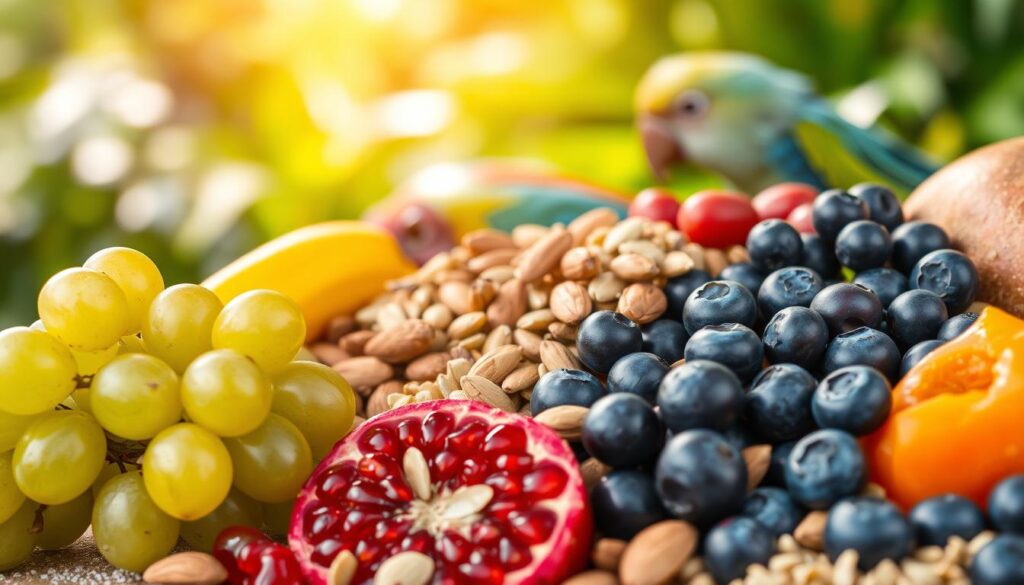
Fruits in Moderation
Fruits should be limited to about 10-15% of the diet due to their high sugar content. Berries, apples (seeds removed), and melons are nutritious options when fed in appropriate portions.
Healthy Grains and Legumes
Cooked legumes like lentils, chickpeas, and split peas provide valuable plant-based protein and fiber. Whole grains such as quinoa, brown rice, and oats offer complex carbohydrates and B vitamins that contribute to sustained energy levels.
| Food Group | Examples | Benefits |
|---|---|---|
| Vegetables | Kale, Spinach, Bell Peppers | Rich in Vitamins and Antioxidants |
| Fruits | Berries, Apples, Melons | High in Vitamins and Fiber |
| Grains and Legumes | Quinoa, Lentils, Brown Rice | Rich in Protein, Fiber, and Complex Carbohydrates |
Feeding Exotic Birds: What’s Safe and What’s Not
The dietary requirements of exotic birds vary significantly across different species, necessitating a tailored approach to their nutrition. Different bird species have unique needs based on their natural habitats, sizes, and metabolic rates.
Species-Specific Dietary Needs
Various bird species require distinct diets. For instance, lories and lorikeets need specialized nectar diets, while macaws require a higher fat content due to their size and natural diet. Smaller birds like finches and canaries thrive on quality seed mixes supplemented with vegetables. In contrast, larger parrots need more diverse diets with a greater emphasis on pellets and fresh foods.
Size Matters: Portion Control for Different Birds
Portion control is crucial for preventing obesity, a common health issue in captive birds that can lead to fatty liver disease, heart problems, and a shortened lifespan. A general guideline is that most birds should consume approximately 10-15% of their body weight in food daily, though this varies by species, age, activity level, and reproductive status.
| Bird Species | Dietary Recommendations | Daily Food Intake |
|---|---|---|
| Small Birds (Finches, Canaries) | Seed mixes, vegetables | 10-15% of body weight |
| Large Parrots (Macaws, Cockatoos) | Pellets, fresh foods, fruits | 10-15% of body weight |
| Lories, Lorikeets | Nectar diets, fruits | Variable, based on activity |
Understanding your bird’s natural feeding ecology provides valuable insights for creating an appropriate captive diet that supports optimal health and natural behaviors.
Toxic Foods That Can Kill Your Bird
Certain foods that are safe for humans can be deadly for birds. As a responsible pet owner, it’s essential to understand which common foods can be hazardous to your pet bird’s health. Some foods contain toxins that can cause a range of symptoms, from mild discomfort to life-threatening conditions.
Avocado and Other Deadly Foods
Avocado is one of the most common toxic foods for birds. The leaves, skin, and pit of the avocado contain persin, a fungicidal toxin that can cause heart damage, respiratory distress, weakness, and even death in birds. Other foods that are toxic to birds include onions and garlic, which contain sulfur compounds that can lead to hemolytic anemia.
Caffeine, Alcohol, and Chocolate
Caffeine and chocolate are highly toxic to birds due to their methylxanthine content, which can cause hyperactivity, increased heart rate, seizures, and death. Alcohol is also extremely dangerous, as it can depress a bird’s organ systems, leading to respiratory failure and death even in small amounts.
Hidden Dangers: Seeds, Pits, and Stems
Fruit seeds and pits from apples, cherries, peaches, plums, and apricots contain cyanide compounds that can be toxic to birds if consumed in sufficient quantities. It’s crucial to keep these out of reach of your pet bird to prevent accidental ingestion.
By being aware of these toxic foods, you can take steps to protect your pet bird and ensure a safe and healthy environment.
Foods to Limit or Avoid
To keep your bird healthy, it’s vital to know which foods should be limited or avoided in their diet. A balanced diet is crucial for maintaining the overall health and well-being of your pet bird.
High-Fat and High-Salt Foods
High-fat foods, such as fried items and fatty meats, can lead to obesity and fatty liver disease in birds, particularly in species like Amazon and Quaker parrots. Similarly, high-salt foods are dangerous because birds’ small bodies can’t process excess sodium effectively, potentially causing dehydration and kidney dysfunction.
Dairy Products and Processed Foods
Dairy products should be limited or avoided as birds lack the enzymes to digest lactose, potentially causing digestive issues. Processed human foods containing preservatives, artificial colors, and flavor enhancers should also be avoided as they can accumulate in a bird’s system and lead to health problems.
| Food Category | Potential Risks | Recommended Action |
|---|---|---|
| High-Fat Foods | Obesity, Fatty Liver Disease | Limit or Avoid |
| High-Salt Foods | Dehydration, Kidney Dysfunction | Limit or Avoid |
| Dairy Products | Digestive Issues | Limit or Avoid |
| Processed Foods | Accumulation of Preservatives, Artificial Colors | Avoid |
Preparing “Chop”: A Nutritional Powerhouse
Preparing “chop” is a simple yet effective way to provide your parrots with a varied and nutritious diet. “Chop” is a mix of finely chopped vegetables, cooked grains, and legumes that can be customized to your bird’s preferences and nutritional needs.
The process of making “chop” involves cooking a large batch of grains and legumes, chopping a variety of vegetables, and mixing everything together in a large container. This mixture can then be portioned out into individual servings and frozen for later use.
Basic Chop Recipe and Variations
A basic “chop” recipe might include ingredients like kale, carrots, bell peppers, broccoli, cooked quinoa, and cooked lentils. However, the beauty of “chop” lies in its versatility, allowing you to adapt the recipe based on seasonal availability and your bird’s preferences.
For example, you can introduce new vegetables or grains to your bird’s diet by mixing them with familiar foods, encouraging dietary diversity. Some bird owners also like to add fruits or nuts to their “chop” recipe for added variety.
| Ingredient | Nutritional Benefit | Example |
|---|---|---|
| Leafy Greens | Rich in Vitamins and Minerals | Kale, Spinach |
| Cooked Grains | Good Source of Fiber and Energy | Quinoa, Brown Rice |
| Legumes | High in Protein and Fiber | Lentils, Chickpeas |
Storage and Serving Tips
Proper storage is crucial to maintaining the freshness and nutritional value of “chop.” It’s recommended to freeze individual portions in silicone molds or ice cube trays for easy thawing. Always discard any uneaten fresh food after 2-4 hours to prevent bacterial growth.
When introducing “chop” to birds accustomed to seeds or pellets only, patience and persistence are key. It may take multiple exposures before acceptance, so it’s essential to be consistent and not give up.
By incorporating “chop” into your bird’s diet, you can provide a nutrient-rich and varied meal that will keep them healthy and happy. With a little planning and creativity, “chop” can become a staple in your bird’s dietary routine.
Transitioning Your Bird to a Healthier Diet
Transitioning your parrot to a healthier diet can be challenging, but with a gradual approach, it’s achievable. Many parrots have never learned how to eat a healthy pellet diet, but they can be taught to do so through a gradual conversion process.
Overcoming Food Resistance
Birds can be notoriously resistant to dietary changes. To overcome this, introduce new foods gradually over 2-4 weeks, replacing seeds with pellets and fresh foods. Morning is often the best time to introduce new foods when birds are hungriest.
Monitoring Health During Diet Changes
Monitor your bird’s weight, droppings, and energy levels closely during transitions. Some birds may initially refuse new foods and could lose weight if the change is too abrupt. Consult with an avian veterinarian before and during major diet transitions.
| Dietary Change | Recommended Timeframe | Monitoring Parameters |
|---|---|---|
| Seeds to Pellets | 2-4 weeks | Weight, droppings, energy levels |
| Introduction of Fresh Foods | Gradual, ongoing | Acceptance, weight, overall health |
Conclusion: Creating a Safe and Balanced Diet for Your Exotic Bird
A well-balanced diet is the cornerstone of maintaining the health and longevity of your exotic bird, and it’s essential to know what’s safe and what’s not. A properly formulated diet consisting of high-quality pellets, fresh vegetables, limited fruits, and appropriate supplements is crucial.
To ensure your pet bird‘s optimal health, regular consultations with an avian veterinarian are vital. Avoiding toxic foods is just as important as providing nutritious ones. By understanding and implementing proper nutrition, you’re giving your exotic bird the best chance for a long, healthy life.
Ultimately, a safe and balanced diet is part of a holistic approach to bird care that includes appropriate housing, enrichment, exercise, and social interaction.
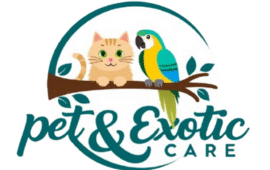

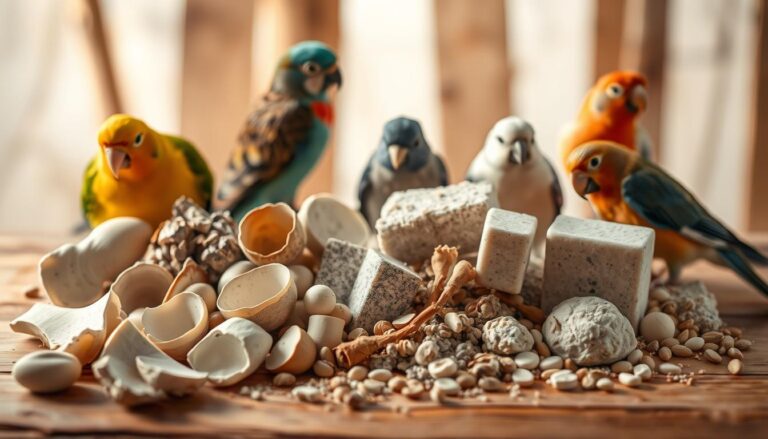
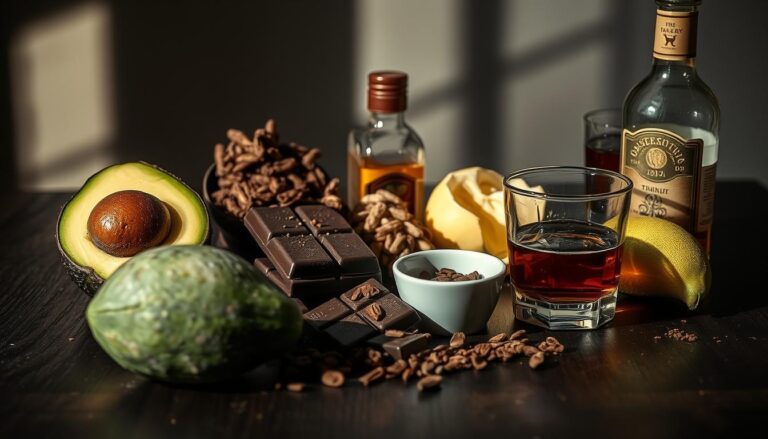
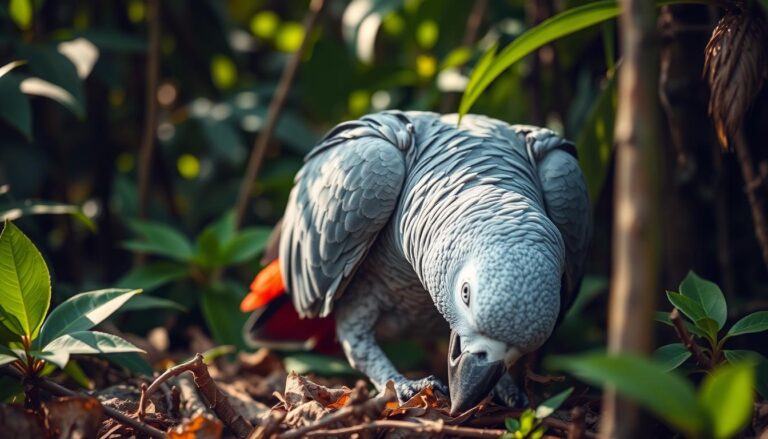
lvfd9f
3nu5eh
qyz03k
3mhfgx